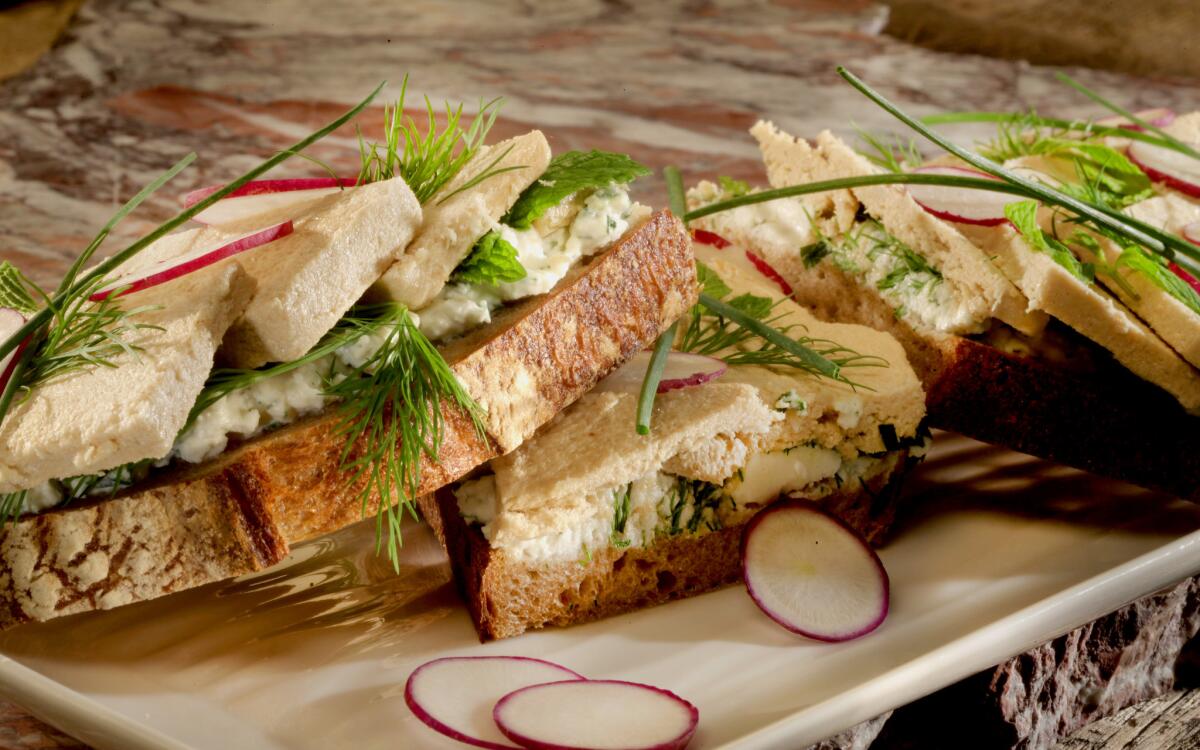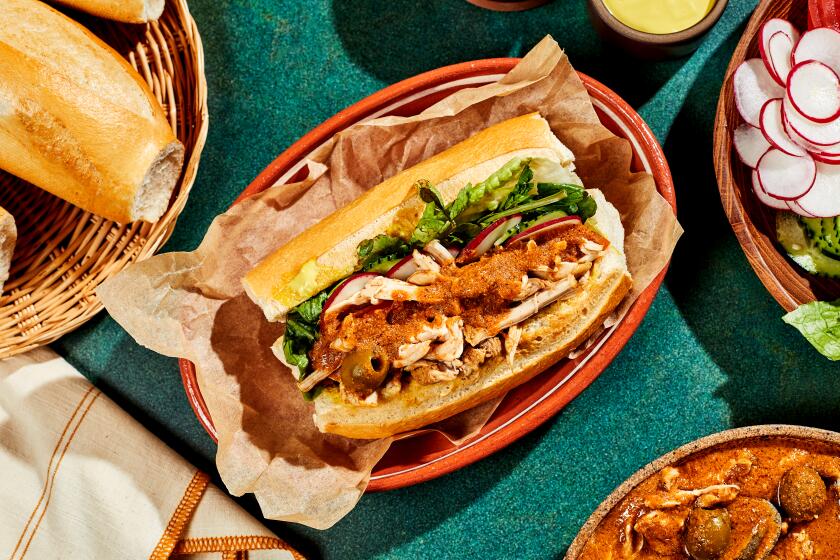Tartines a la perse (Persian toasts)

Katie Gurvin plunges her aqua-gloved arms into the bowl of hot tahini-sugar-fluff mixture and begins to work her magic. Hints of vanilla, caramel and sesame waft up as the young halvah maker repeatedly twirls her hands through the tawny batter. As spaghetti-like strands form, she lifts, stretches and lets them drop, her movements somewhere between pulling Chinese noodles and taffy. When the stuff resembles a bread sponge, Gurvin shifts to powerful kneading until finally the metamorphosis is complete — the once soupy mixture is now a pale 35-pound mass of sesame halvah, one of the world’s most ancient confections.
If you’re already familiar with the dense tahini-based sweet found in ethnic markets and delis, you may have wondered how the stuff is made. If you’re like many Americans, you may know tahini — but halvah? Not so much. The best halvah is tahini-forward and shot with spun sugar, each bite yielding a delicate shatter before dissolving in a creamy, nutty finish.
Since June, Gurvin and her Israeli American husband, Scott Hebel, have been handcrafting organic, vegan, Levant-style sesame halvah at Hebel & Co. in Los Angeles. The duo works in a Crafted Kitchen incubator space in the Industrial Arts section of downtown Los Angeles, where they manufacture 220 to 500 pounds of halvah per week in five flavors — vanilla, pistachio, chocolate-hazelnut, bittersweet marble and hot cocoa — that they sell to retailers and restaurants, at the Hollywood farmers market and online. (They’ll be scaling up when they move into their own kitchen in April.)
Halvah — the name comes from the Arabic word for sweetmeat — has been around since at least 7th century Persia, where it was then likely made from semolina. Versions made from grains, vegetables and nuts are popular in South Asia, Ukraine and parts of the Levant, but the most famous is sesame halvah from the Middle East, Turkey and Greece. It’s traditionally enjoyed with afternoon coffee or tea, for dessert; or, in Iran, as an earthy-sweet counterpoint to an appetizer platter of herbs, radishes, feta cheese and flatbread.
Thanks to chefs such as Yotam Ottolenghi, Michael Solomonov and Alon Shaya, Israeli and Middle Eastern cuisines are catching on with chefs whose cooking has no connection to the Eastern Mediterranean. This month, Forbes named tahini, halvah’s main ingredient, a breakout growing food trend.
For Hebel, it all began with a simple desire to re-create his Bukharan-Polish-Austrian-Israeli family’s weekend tradition.
“Every Saturday morning when I was a kid, my dad bought bagels and halvah,” says the New Jersey native. “It was our version of weekend waffles.” As he developed a passion for food, Hebel wanted a better version of his childhood treat than the “industrially produced stuff I mostly ate growing up.”
Hebel has spent his adult life seeking out great halvah, from Chicago, where he worked in the tech industry, and Los Angeles to Israel, Egypt and Greece — he’s even sampled nonsesame halvah in India. But he couldn’t find the caliber he wanted locally. Good halvah depends on the quality of ingredients, a tahini-sugar ratio (at least 50% tahini) and how well the finished product is cared for — heat and moisture are the enemy of sugar work.
Hebel says he thought, “It’s basically three ingredients — tahini, sugar and an emulsifier — how hard could it be to make?”
“Well, every recipe out there is wrong,” he adds. “Egg whites aren’t used to bind tahini’s fat with caramelized sugars in traditional halvah-making.” The most authentic recipes use an aromatic plant-based extract as a foaming agent (think aquafaba), which gives classic halvah its light color, airy texture and hint of bitterness. Hebel and Gurvin call this the “fluff.” The couple use Philadelphia-based Israeli Soom tahini (soomsoom is Hebrew for sesame) and a proprietary blend of manufacturing sugars, but no invert sugars whose intense sweetness overpowers tahini’s delicate flavor.
According to Hebel, the ancient art has mostly been handed down orally through the generations. It took seven years, beginning in 2010, of translating medieval Arabic texts, studying chemistry and sugar work, and experimenting to get the formula just right. Gurvin, a former director of sales and marketing at the restaurant and marketplace Farmshop in Brentwood, brought her love of bread baking, her PR skills and a fresh eye to the endeavor. She’s from a Midwestern Catholic family and had zero halvah knowledge before she met Hebel.
All the while, Hebel continued his search for U.S. halvah makers. After 20 years developing software, the 41-year-old “was fortunate to have enough to capitalize the dream of a halvah start-up, with the help of friends and family.”
Hebel and Gurvin nudge the slab of halvah into shape. It’s a well-choreographed division of labor — he does the chemistry bits, she takes the lead where her baker’s skills are required. “The basic steps are the same, but every batch, every day, is different,” they say. As with breadmaking or sugar work, halvah production is as much about “feel” as science. “Things can go south pretty quickly,” Gurvin says. “You don’t want to end up with fudge, marzipan or anything dry and crumbly.” Says Hebel: “The magic of halvah is not breaking those strands.”
Their commitment is not lost on the restaurant industry. In rotation on the Farmshop menu are chicken liver mousse with bitter-lemon marmalade, labneh panna cotta with grapefruit marmalade and a mocha-almond tart with pistachio gelato, all embellished with halvah. On weekends, Roxana Jullapat bakes halvah croissants at Friends & Family in Los Angeles, and Alex Phaneuf and Or Amsalam of Lodge Bread in Culver City offer babka stuffed with chocolate and halvah. Dahlia Narvaez serves tahini, halvah and nut milk sorbet at Osteria Mozza because, she says, “you see a lot of sesame in Italian cooking, so it’s a natural bridge to include [halvah] desserts on our menu.”
You don’t need to go to such effort at home. Besides eating it “straight up” or on bagels, Gurvin suggests crumbling it over yogurt-granola parfaits or ice cream, or adding it to a cheese plate.
Other ideas include crisp-and-gooey halvah panini, or melting chocolate over blocks of halvah for a simple, showy dessert paired with fruit and nuts. Or make Persian-style springtime tartines, a great dish for celebrations such as Nowruz, Easter and Passover.
Gurvin shaves off the top of the still-warm batch, exposing an airy stack of shaggy halvah tiles. With each bite, one hears the crunch of sugar threads, as with the crystals in well-aged cheese. The couple set aside the batch to cool overnight and move on to cutting and wrapping the previous day’s giant “sheet cakes” of halvah for delivery. “We didn’t start out to become a business,” they say. “It was simply a labor of love.”
Hebel & Co. halvah is available at the Sunday Hollywood farmers market, Farmshop, Lincoln, Little Flower, Monsieur Marcel and online at hebelco.com. $12 for 6.3-ounce block.
Stir together feta cheese and enough crème fraîche to make a nice spread. Chop enough of 1 or 2 of your chosen herbs to yield 2 tablespoons. Snip most of the chives into 1/8- to ¼-inch pieces. Stir the chopped herbs and chives into cheese. Thinly slice or julienne the radishes. Cut the halvah into thin slices.
Toast the bread. Divide the cheese mixture among the slices, spreading it over each of the toasts. Lay several of the largest whole leaves from your selection of herbs over the cheese along with any remaining whole chives as desired. Arrange several slices of halvah over the herbs. Top generously with radishes, mint and any other small herb leaves. Cut the tartines in half and serve.
Get our Cooking newsletter.
Your roundup of inspiring recipes and kitchen tricks.
You may occasionally receive promotional content from the Los Angeles Times.















